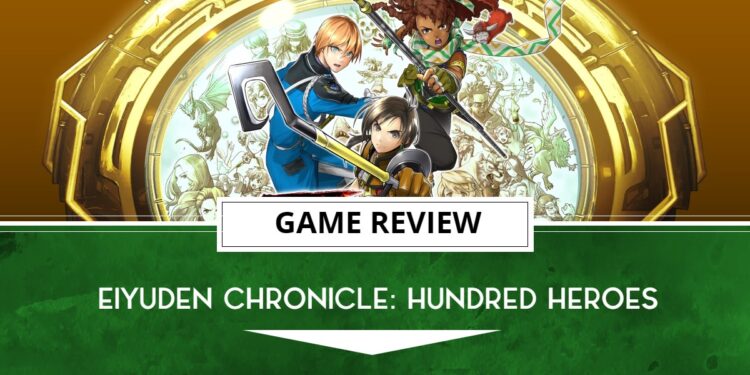If there’s one thing that can be said about Eiyuden Chronicle: Hundred Heroes, it’s that fans of role-playing games from the late 1990s will instantly connect with it. A lot of the same characteristics that made up the classics of the genre from that era are here in a big way. Many of those same RPG fans will herald games like Suikoden 2 as marquee titles, and it’s very fitting because Eiyuden Chronicles is made by the same developer, Yoshitaka Murayama, who also created the Suikoden series. But while this spiritual successor to Suikoden inherits all its best aspects, Eiyuden Chronicle: Hundred Heroes also inherits a lot of the same problems from it as well.
Game Name: Eiyuden Chronicle: Hundred Heroes
Platform(s): Xbox Series X/S (Reviewed), PlayStation 5, Switch, PC
Developer(s): Rabbit & Bear Studios
Publisher(s): 505 Games
Release Date: April 23rd, 2024
Price: $49.99
The plot of the game follows a young man named Nowa as he gathers allies from all over the land to help fight in a revolution against an invading empire. Much like the Suikoden series, the main storyline is focused on two friends who find themselves on opposite sides of a greater conflict. Along the way, Nowa comes across many different characters that come together through various means, each with their own stories and motivations that become entwined with everything going on. The story takes place after the prequel game set in the same world, Eiyuden Chronicle: Rising, and involves some of the same characters that appeared there.
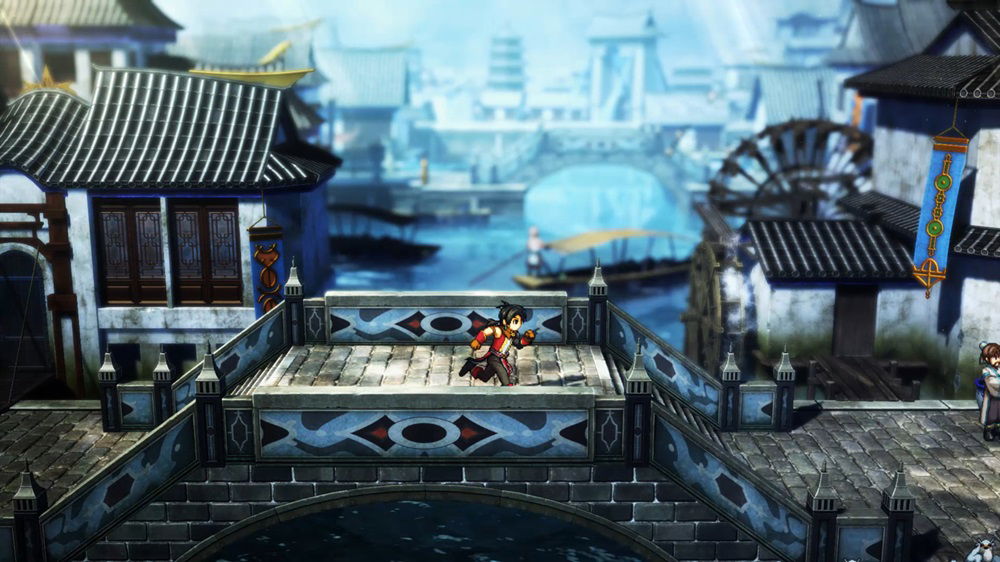
A JRPG Link to the Past
It takes a while for the plot of Eiyuden Chronicle: Hundred Heroes to get moving. Much like its big inspiration, many portions of the story can feel like they drag on for longer than they need to. This is especially true for earlier sections of the game before you’re able to travel around the map to recruit allies. While there are witty sections of dialogue and interactions between many of the large cast of characters, not everything you see and hear from them will land as well as it should. Fans of anime storytelling will enjoy much of what Eiyuden Chronicle tackles, but others may struggle to connect with any of the characters or humor that is widespread throughout the game.
But does Eiyuden Chronicle: Hundred Heroes still play as great as the Suikoden series that everyone praises? Well, it’s almost identical in a lot of ways. You can have up to six characters in your party, with support and extra side characters that are inactive. Everyone can level up to improve their attacks and abilities as you get into random battles and progress the story. While multiple characters can fulfill similar roles, they won’t always have the same abilities open to them. This gives a lot of room for mixing up your team of heroes for different turn-based battles, especially in challenging boss fights you encounter. Different characters can also use team attacks that can deal massive damage when used at the right time, encouraging you to experiment with different allies you add to your party. They look flashy and really impact the battles you get into.
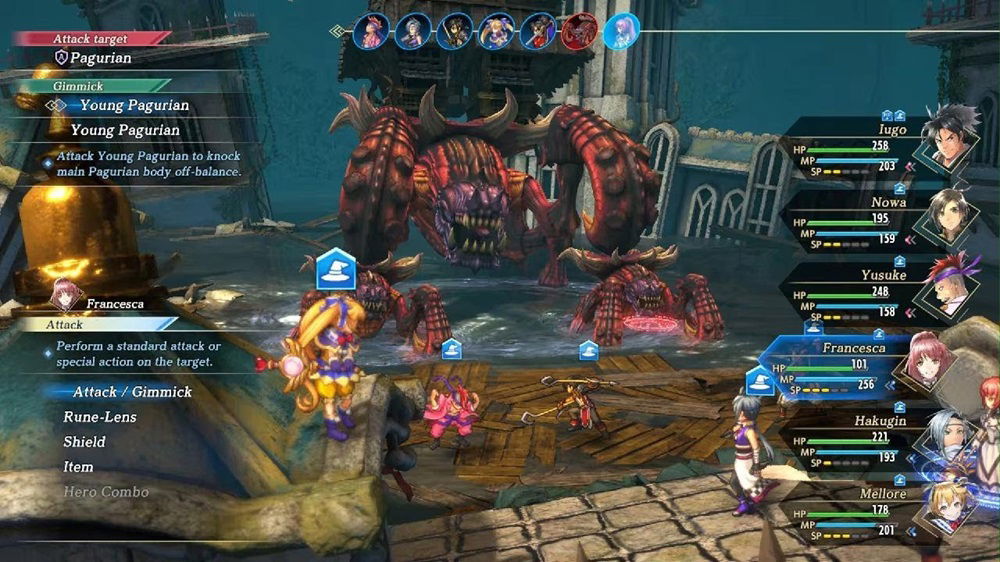
However, battles can also become very trivial over time. Like in Suikoden, you can use the Auto feature to let battles play out without controlling them, allowing you to just watch fights happen. It can be helpful when you’re trying to get more EXP and items for your party, but will also take out any of the strategy from battles. For some players, this will be a great way to get through most sections of the game, but others won’t pick up the nuances of their characters’ abilities in battles by doing so. The Auto feature can be done in any fight within the game, but is not the best option when taking on boss battles where you need to pay attention to certain gimmicks that come into play. It’s in these moments that timing your attacks and other actions play a key part in scoring a victory, which you do not fully utilize when using Auto constantly.
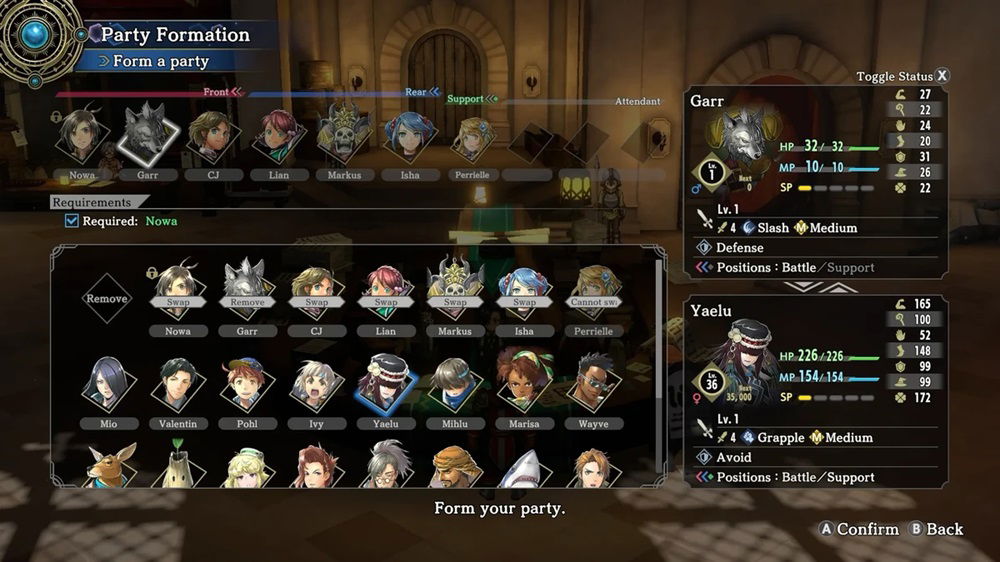
Problems Lingering from Back Then
Outside of battle, Eiyuden Chronicle: Hundred Heroes also suffers from the same poor design choices that plagued Suikoden. Item management can get very annoying when you have a limited amount of space for the majority of the game, and when items aren’t limited to one listing. You might find yourself having a clump of six health items multiple times that take up so much space, preventing you from opening up chests or purchasing items from shops, forcing you to discard or waste items to make room. It’s a terrible design choice for storage that did not work well in the Suikoden games, and it doesn’t fair better here.
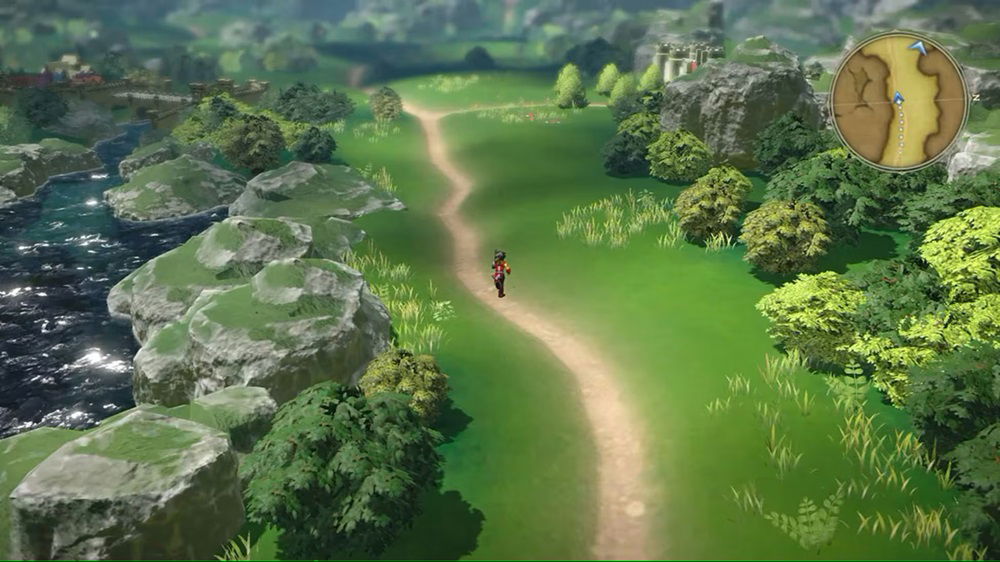
The same thing can be said for abilities that you gain for exploring areas on the world map and within specific locations. It can be a struggle getting around at first due to the limitations that the party has with movement, but this can be improved on as you find new items and characters to expand that. However, you often aren’t given a hint or insight into how to do so. Abilities like better movement speed, fast travel between locations, more options at save points, and other quality-of-life enhancements are possible. But you’ll end up accidentally discovering them by chance rather than seeing something in-game to indicate their possibility. This can be even more annoying when some of those same abilities are tied to equipment or characters, which are lost if you remove them from your main party. A lot of this could be alleviated if quality-of-life enhancements were put onto key items that stick with your party all the time, regardless of who is active or not.
Weapons and equipment management are pretty much the same as in Suikoden. You don’t find or equip new weapons, but instead improve the weapons of every character individually at the Smith shop. New armor and accessories are found throughout the world in chests or as rewards for battles. Runes are also a major part of growing the strength of your party, which opens up magic abilities and other perks for them. None of this is new territory for anyone who’s played a Suikoden game before this, but it’s a lot to get into for everyone else. In addition, access to customizing these parts of your characters takes a while to open up, requiring you to advance the main story beforehand.

Taking a While to Really Explore
Speaking of which, Eiyuden Chronicle: Hundred Heroes takes a long time to give you access to its side content and other aspects of the game. Eventually, during the main story, Nowa can manage a castle with his allies, building facilities and more for them. When this happens, you can start to get the opportunity to open up the strength of your characters, as well as new side stories to gain new allies. Gathering the right materials and funds to open up your castle more will take you all over the world map to many locations, so don’t expect to build up a castle early on.
It’s great to have all of this as part of the game, but it takes a long time getting there to experience it. The same can be said for other side activities, like a card battle mini-game, large-scale army battles, fishing, eggfoot racing, and other mini-games. You’ll have to progress hours of the main story before you can catch a glimpse of that. The card battles are simple mini-games that require a bit of luck and strategy, but can be interesting. You get a whole facility to build in your castle to play after gaining the right ally. The army battles happen at various times in the main story, which pit you against enemy forces with your allies. Often these battles feel guided, but you do have options to strategize and move against enemy legions.
More than anything else, these battles stretch out certain sections of the story rather than becoming deeper side activities. Not every mini-game is necessary to progress the main story, but you might go for a long time before you ever come across something to open them up.

Eiyuden Chronicle: Hundred Heroes is a game that prides itself on feeling like something that Japanese role-playing game fans remember fondly. For better or worse, the game accomplishes that in many ways that connoisseurs of the genre will appreciate very much. Its presentation also stands out with great visuals and a fantastic soundtrack. As a whole, Eiyuden Chronicle: Hundred Heroes looks like it could’ve been dropped into the same era as the games that inspired it. But that also comes with many negatives of the time that the game does not improve upon at all, which hold it back from being something even greater.
Eiyuden Chronicle: Hundred Heroes is available on PlayStation 5, Xbox Series X, Nintendo Switch, and PC.
Review Disclosure Statement: Stellar Blade was purchased for review purposes. For more information on how we review video games and other media/technology, please review our Review Guideline/Scoring Policy.
Affiliate Link Disclosure: One or more of the links above contain affiliate links, which means at no additional cost to you, we may receive a commission should you click through and purchase the item.
Summary
Eiyuden Chronicle: Hundred Heroes gets a lot of things right for fans of Japanese role-playing games. It has great visuals and a great soundtrack that complements everything. But poor design choices from the classic games that inspired it can negatively impact the whole experience. The main story may also not be that good for everyone, which can take a long time to play through.
Pros
- Great visuals with interesting sprites and backgrounds
- Fantastic soundtrack
- Large cast of playable characters
- Multiple activities outside the main story
Cons
- Main story may not be interesting for some players
- Poor design for item management
- Quality-of-life features locked to certain items or characters
- Harsh difficulty spikes in a few areas
- Some story sections drag for too long
-
Eiyuden Chronicle: Hundred Heroes


